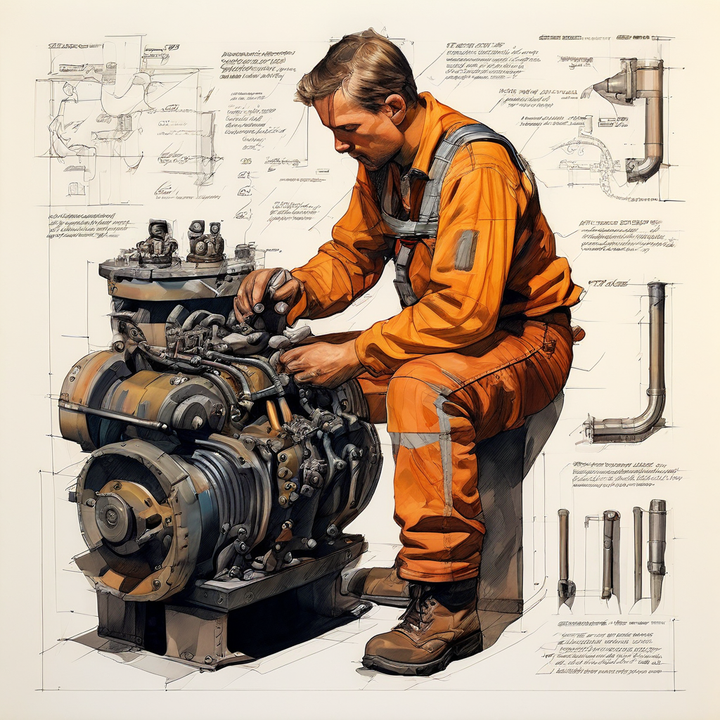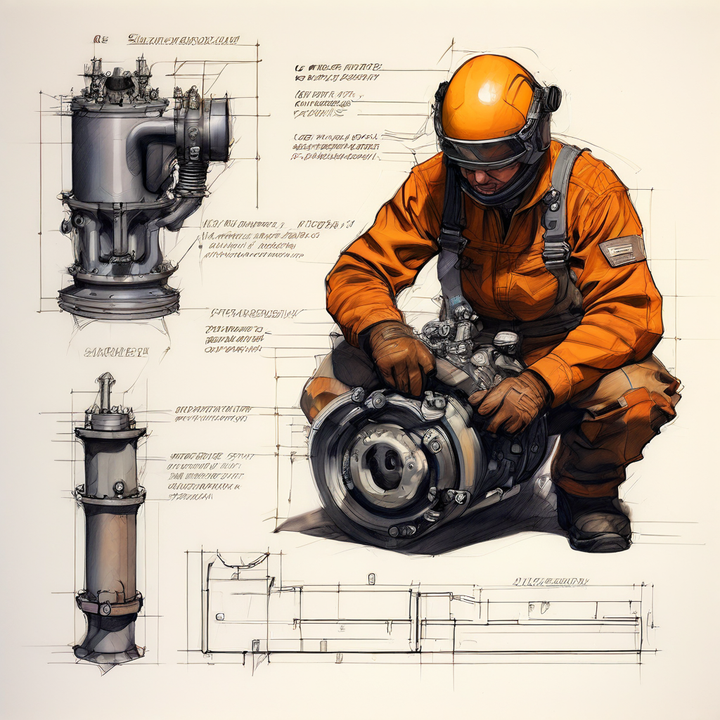


The diagnostic trouble code (DTC) P03E4 indicates an issue with the combustion performance of cylinder 8 in the engine. This code is set by the engine control module (ECM) when it detects a misfire or incomplete combustion occurring specifically in cylinder 8.
Imagine this scenario: you're cruising down the highway, reveling in the melodic purr of your engine, when suddenly, the dreaded check engine light illuminates. Your heart sinks, and you wonder, "What could it be this time?" After a quick scan, the culprit reveals itself – P03E4, a code that points to an issue with the combustion performance in cylinder 8.
Now, before we dive into the nitty-gritty details, let me assure you that this code isn't as daunting as it may seem. With a little know-how, some elbow grease, and a systematic approach, we can get to the bottom of this automotive mystery and restore your engine to its former glory.
Like any good detective, we must first examine the usual suspects. In the case of P03E4, the potential causes are numerous, but some stand out as the most likely offenders:
| Potential Cause | Description |
|---|---|
| Faulty Fuel Injector | This little guy is responsible for delivering the perfect amount of fuel to cylinder 8, but when it malfunctions, the combustion process goes haywire. |
| Leaky Valve | Imagine a door that won't close properly – that's what a leaky intake or exhaust valve does to your engine. It disrupts the delicate balance of air and fuel, leading to poor combustion. |
| Worn Piston Ring | These unsung heroes play a crucial role in maintaining compression within the cylinder. When they're worn out, compression suffers, and combustion becomes a real struggle. |
| Ignition System Woes | A faulty spark plug or ignition coil can leave cylinder 8 feeling like a neglected stepchild, unable to ignite the air-fuel mixture properly. |
| Vacuum Leak | Like a pesky draft in your house, a vacuum leak can wreak havoc on your engine's combustion process, causing cylinder 8 to underperform. |
Now that we know the potential suspects, it's time to put on our detective hats and start investigating. Here's how we'll approach this automotive mystery:
This is like reviewing the security footage from the crime scene. We'll look for any clues related to misfires or combustion issues in cylinder 8. The freeze frame data can provide valuable insights into the engine's operating conditions when the code was set, such as:
Engine load
Coolant temperature
Fuel trim values
Misfire counters
Think of this as a lie detector test for your engine. We'll check the compression in cylinder 8 to see if it's up to snuff. Low compression can be a telltale sign of worn piston rings, leaky valves, or other internal engine issues.
Here's how we'll conduct the compression test:
Warm up the engine to operating temperature.
Disable the ignition system to prevent the engine from starting.
Remove the spark plug from cylinder 8.
Insert a compression tester into the spark plug hole.
Crank the engine and record the compression reading for cylinder 8.
Compare the reading to the manufacturer's specifications and the readings from the other cylinders.
Time to dust for fingerprints! We'll take a closer look at the fuel injector, spark plug, and ignition coil for cylinder 8, checking for any signs of foul play.
Fuel Injector: Look for signs of clogging, leaks, or electrical issues that could prevent proper fuel delivery.
Spark Plug: Inspect the electrode condition, gap, and insulator for signs of wear or damage.
Ignition Coil: Check for any visible damage, loose connections, or signs of arcing.
Like a bloodhound on the trail, we'll sniff out any vacuum leaks, especially around those pesky intake manifold gaskets. Vacuum leaks can cause lean air-fuel mixtures, leading to poor combustion and potential engine damage.
Here are some common methods for detecting vacuum leaks:
Visual inspection: Look for cracked or damaged hoses, gaskets, and seals.
Smoke test: Introduce smoke into the intake system and watch for leaks.
Vacuum gauge: Monitor the vacuum gauge while spraying soapy water around potential leak areas.
This is our final interrogation technique. We'll use a leak-down tester to grill those valves and see if any of them are spilling the beans. A leak-down test can help identify leaky valves, worn piston rings, or other internal engine issues that could be causing the P03E4 code.
Here's how we'll conduct the leak-down test:
Remove the spark plug from cylinder 8.
Install the leak-down tester into the spark plug hole.
Pressurize the cylinder to the recommended pressure.
Listen and observe for any leaks from the intake, exhaust, or crankcase.
Compare the leak-down percentage to the manufacturer's specifications.
Once we've cracked the case and identified the culprit, it's time to take action. Depending on the root cause, we may need to:
Replace the faulty fuel injector for cylinder 8
Swap out the spark plug and ignition coil
Rebuild the engine or replace those worn piston rings (a costly endeavor, but sometimes necessary)
Perform a valve job or replace leaky valves
Seal those pesky vacuum leaks by replacing hoses or gaskets
But our job doesn't end there, my friends. To prevent a repeat offense, we must take preventive measures:
| Preventive Measure | Description |
|---|---|
| Follow Maintenance Schedule | Adhere to the manufacturer's recommended maintenance schedule for spark plugs, air filters, and other components. |
| Use High-Quality Fuel | Use only the highest-quality fuel and keep that fuel system squeaky clean to prevent buildup and contamination. |
| Avoid Excessive Stress | Avoid excessive idling or high engine loads that could stress your engine and accelerate wear. |
| Address Other Issues | Address any other engine codes or issues promptly, before they escalate into a full-blown crisis. |
While the P03E4 code may seem daunting at first, with a little know-how, a systematic approach, and some good old-fashioned elbow grease, we can crack this automotive mystery. Remember, preventive maintenance is key, and addressing issues promptly can save you from costly repairs down the line.
So, fellow gearheads, fear not the P03E4 code! Embrace the challenge, and let's keep our engines running smoothly for years to come. Happy wrenching!
The common causes of the P03E4 code include faulty fuel injector, leaking or stuck intake/exhaust valves, worn piston rings or low compression, ignition system issues like bad spark plug or coil, and vacuum leaks affecting cylinder 8.
To perform a compression test for cylinder 8, warm up the engine, disable the ignition system, remove the spark plug, insert a compression tester, crank the engine, and record the compression reading for cylinder 8.
You should inspect the fuel injector, spark plug, ignition coil, and check for vacuum leaks, especially around the intake manifold gaskets, to diagnose the root cause of the P03E4 code.
You can detect vacuum leaks by visually inspecting for cracked or damaged hoses, gaskets, and seals, performing a smoke test, or using a vacuum gauge while spraying soapy water around potential leak areas.
A leak-down test is used to identify leaky valves, worn piston rings, or other internal engine issues. It involves removing the spark plug, installing a leak-down tester, pressurizing the cylinder, and observing for leaks from the intake, exhaust, or crankcase.
Potential repairs for the P03E4 code include replacing the faulty fuel injector, spark plug, ignition coil, rebuilding the engine or replacing piston rings, performing a valve job or replacing leaky valves, and sealing vacuum leaks by replacing hoses or gaskets.
To prevent the recurrence of the P03E4 code, follow the manufacturer's recommended maintenance schedule, use high-quality fuel and keep the fuel system clean, avoid excessive idling or high engine loads, and address any other engine codes or issues promptly.
Following the manufacturer's recommended maintenance schedule for components like spark plugs and air filters is crucial to prevent issues like the P03E4 code and ensure optimal engine performance.
Using high-quality fuel and keeping the fuel system clean is important to prevent buildup and contamination, which can lead to issues like the P03E4 code and other engine problems.
The cost of repairs for the P03E4 code can vary significantly, ranging from a few hundred dollars for replacing a fuel injector or spark plug to thousands of dollars for rebuilding the engine or replacing piston rings, depending on the root cause and extent of damage.

Miguel started tinkering with car radios as a teenager, fascinated by the intricate dance of wires and circuits. This passion led him to pursue a career as an automotive electrician. For the past 10 years, Miguel has tackled everything from flickering headlights to mysterious electrical gremlins. He thrives on troubleshooting electrical problems and enjoys sharing his knowledge to empower car owners to understand their vehicles better.



